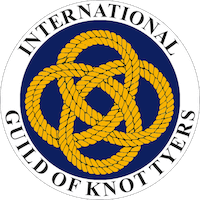A Practical Approach to Circular Knotworks consisting of pattern No. 295 by Alexander Åström & Christoffer Åström
IGKT 2017 ISBN 978-0-99-319080-3
This book is concerned with knot works based on a recurring loop pattern denoted No. 295, with the loops arranged in circular layers, which may have additional layers of Turks Heads.
295, with the loops arranged in circular layers, which may have additional layers of Turks Heads.
Previous works by the authors gave an equation for the number of strands to be used for a given knot work and this was then extended to include the use of additional layers of Turks Heads. The aim of this publication is to summarise the mathematical method in such a way that it allows the knotter to design their required knot work in a systematic way. It also discusses the practical limitations of the theoretical approach and gives a number of worked examples. The object is to allow the reader to generate a grid diagram for their chosen knot work. A grid diagram is the actual layout over which the rope is laid, such as that illustrated below.

“The knot work is characterised by the number of circular layers (l), the number of loops in the innermost layer (d1) and a vector (k) which defines the way the layers link together. The relation between the number of loops in layer i (di) and d1 is given by di = d1.2i-1 ”.
This gives a flavour for the level of mathematical familiarity assumed for this book. If you feel happy with that, then this publication achieves its aims and will give you the tools to construct your own mats designed on the basic loop. The description of the approach is detailed and clearly described in stages with many explanatory diagrams, so that by following the instructions you can generate the required grid diagram for the chosen pattern.
The level of detail is impressive, but for anyone who has tried even a simple rope mat perhaps the most stunning elements are the worked examples. The mathematics in the examples are worked through in very clear steps and the final grid diagrams are shown with completed mats. These pictures alone could well justify getting the book.
The description of the approach is detailed and clearly described in stages with many explanatory diagrams, so that by following the instructions you can generate the required grid diagram for the chosen pattern. The level of detail is impressive, but for anyone who has tried even a simple rope mat perhaps the most stunning elements are the worked examples. The mathematics in the examples are worked through in very clear steps and the final grid diagrams are shown with completed mats. These pictures alone could well justify getting the book.
My one disappointment with the book is that it avoids discussing the vexed issue of length of rope required, beyond the statement “Estimating the length of rope can be quite troublesome...” together with a reference to a rather obscure article. Given the care lavished on other aspects of the approach this is a pity, as every knot tyer knows the frustration of estimating the length needed, particularly for large complicated items such as these mats. Given that each of the examples was constructed so beautifully, even a table simply giving the lengths of material used in each case would have been of help in providing a baseline for an order-of-magnitude estimate.
In conclusion, the authors have produced a well set-out and detailed description of how to generate rope mats of the required form, which amply meets their stated objective. A certain level of mathematical competence is needed to work through the method, but even for the less mathematically inclined, the worked examples would provide sufficient challenge for many happy hours of knotting, and the pictures of the work alone can justify a place for the book on a knot tyer’s shelf. As with all good works, they have left room for future advances, the next challenge being an equation for the length of rope required!
Christopher Jenkins
Note: With the author's full permission,this book has been published by the Guild and is available from the Supplies Secretary.

